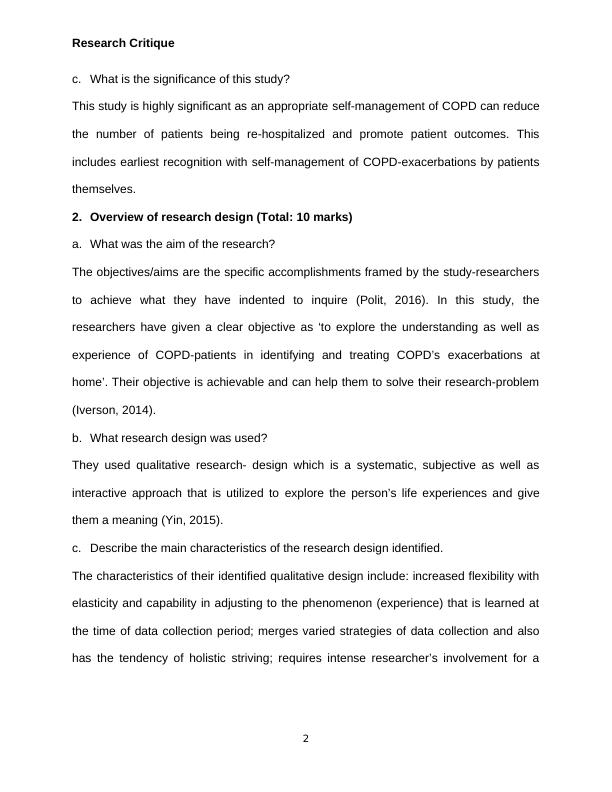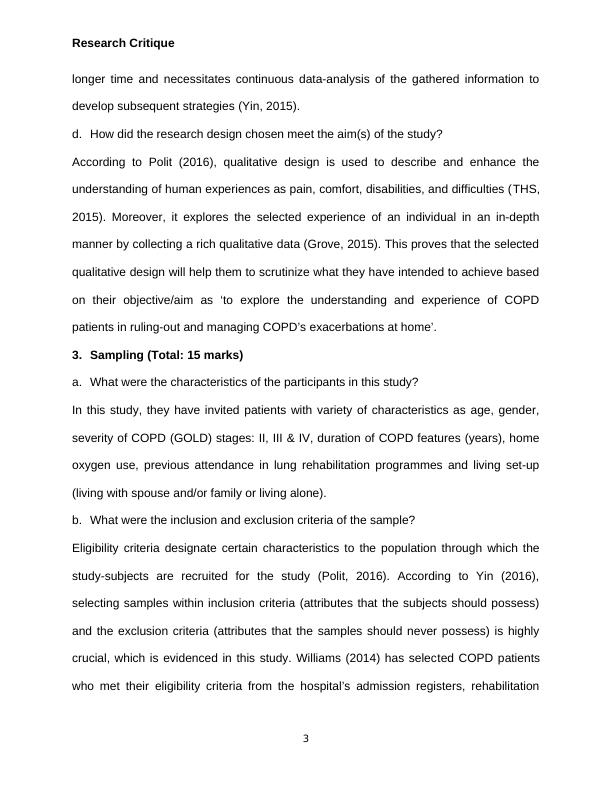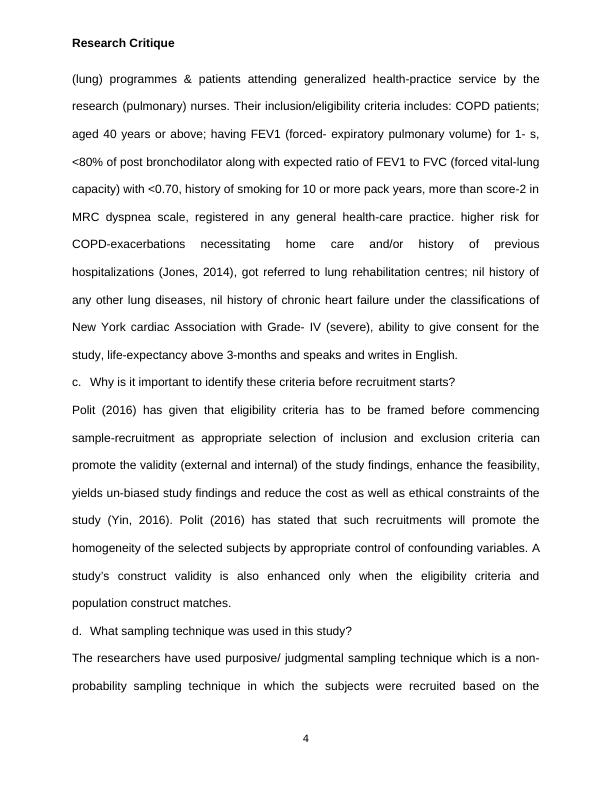Guided Review of Qualitative Literature on COPD Exacerbations
Added on 2023-06-11
11 Pages2890 Words367 Views
Research Critique
Assessment 2 Guided Review of nominated literature (QUALITATIVE)
1. Background of the study (Total: 10 marks)
a. What is the health issue that provides the focus of this study?\
This study focuses on the chronic- obstructive pulmonary disease (COPD)
exacerbations that affect one out of three UK patients requiring re-hospitalizations in 28
days of previous admission. Adequate self management techniques can reduce re-
hospitalizations and promote outcomes in COPD-patients (Linton, 2015). According to
Brown (2017), patients are the core people who can trace-out their own health-condition
alterations and hence they should understand meaning of COPD-exacerbations,
recognize deteriorating symptoms and react adequately. Therefore, Williams (2014)
explores the understanding of experience in recognizing and self-managing COPD-
exacerbations in this study.
b. Generally, what have been the results of previous studies of this issue?
The previous studies show that there is no clear definition, method of identifying and
understanding of exacerbations by COPD-patients. Some studies specify that the
COPD-patients don’t have clear understanding of the exacerbation’s meaning while
certain studies indicate that COPD-patients understand these terms. Harrison’s (2013)
meta-analyses indicate that previous qualitative researches have only investigated
about the experience of exacerbations among COPD-patient’s but not about the method
of identifying exacerbation. Patients are found to feel comfortable to self-manage
COPD-exacerbation at-home. Despite, several studies publishing about assessment of
exacerbations (Sundh, 2013), still no clear evidence is found about recognition and self-
management of exacerbations (Risor, 2013).
1
Assessment 2 Guided Review of nominated literature (QUALITATIVE)
1. Background of the study (Total: 10 marks)
a. What is the health issue that provides the focus of this study?\
This study focuses on the chronic- obstructive pulmonary disease (COPD)
exacerbations that affect one out of three UK patients requiring re-hospitalizations in 28
days of previous admission. Adequate self management techniques can reduce re-
hospitalizations and promote outcomes in COPD-patients (Linton, 2015). According to
Brown (2017), patients are the core people who can trace-out their own health-condition
alterations and hence they should understand meaning of COPD-exacerbations,
recognize deteriorating symptoms and react adequately. Therefore, Williams (2014)
explores the understanding of experience in recognizing and self-managing COPD-
exacerbations in this study.
b. Generally, what have been the results of previous studies of this issue?
The previous studies show that there is no clear definition, method of identifying and
understanding of exacerbations by COPD-patients. Some studies specify that the
COPD-patients don’t have clear understanding of the exacerbation’s meaning while
certain studies indicate that COPD-patients understand these terms. Harrison’s (2013)
meta-analyses indicate that previous qualitative researches have only investigated
about the experience of exacerbations among COPD-patient’s but not about the method
of identifying exacerbation. Patients are found to feel comfortable to self-manage
COPD-exacerbation at-home. Despite, several studies publishing about assessment of
exacerbations (Sundh, 2013), still no clear evidence is found about recognition and self-
management of exacerbations (Risor, 2013).
1

Research Critique
c. What is the significance of this study?
This study is highly significant as an appropriate self-management of COPD can reduce
the number of patients being re-hospitalized and promote patient outcomes. This
includes earliest recognition with self-management of COPD-exacerbations by patients
themselves.
2. Overview of research design (Total: 10 marks)
a. What was the aim of the research?
The objectives/aims are the specific accomplishments framed by the study-researchers
to achieve what they have indented to inquire (Polit, 2016). In this study, the
researchers have given a clear objective as ‘to explore the understanding as well as
experience of COPD-patients in identifying and treating COPD’s exacerbations at
home’. Their objective is achievable and can help them to solve their research-problem
(Iverson, 2014).
b. What research design was used?
They used qualitative research- design which is a systematic, subjective as well as
interactive approach that is utilized to explore the person’s life experiences and give
them a meaning (Yin, 2015).
c. Describe the main characteristics of the research design identified.
The characteristics of their identified qualitative design include: increased flexibility with
elasticity and capability in adjusting to the phenomenon (experience) that is learned at
the time of data collection period; merges varied strategies of data collection and also
has the tendency of holistic striving; requires intense researcher’s involvement for a
2
c. What is the significance of this study?
This study is highly significant as an appropriate self-management of COPD can reduce
the number of patients being re-hospitalized and promote patient outcomes. This
includes earliest recognition with self-management of COPD-exacerbations by patients
themselves.
2. Overview of research design (Total: 10 marks)
a. What was the aim of the research?
The objectives/aims are the specific accomplishments framed by the study-researchers
to achieve what they have indented to inquire (Polit, 2016). In this study, the
researchers have given a clear objective as ‘to explore the understanding as well as
experience of COPD-patients in identifying and treating COPD’s exacerbations at
home’. Their objective is achievable and can help them to solve their research-problem
(Iverson, 2014).
b. What research design was used?
They used qualitative research- design which is a systematic, subjective as well as
interactive approach that is utilized to explore the person’s life experiences and give
them a meaning (Yin, 2015).
c. Describe the main characteristics of the research design identified.
The characteristics of their identified qualitative design include: increased flexibility with
elasticity and capability in adjusting to the phenomenon (experience) that is learned at
the time of data collection period; merges varied strategies of data collection and also
has the tendency of holistic striving; requires intense researcher’s involvement for a
2

Research Critique
longer time and necessitates continuous data-analysis of the gathered information to
develop subsequent strategies (Yin, 2015).
d. How did the research design chosen meet the aim(s) of the study?
According to Polit (2016), qualitative design is used to describe and enhance the
understanding of human experiences as pain, comfort, disabilities, and difficulties (THS,
2015). Moreover, it explores the selected experience of an individual in an in-depth
manner by collecting a rich qualitative data (Grove, 2015). This proves that the selected
qualitative design will help them to scrutinize what they have intended to achieve based
on their objective/aim as ‘to explore the understanding and experience of COPD
patients in ruling-out and managing COPD’s exacerbations at home’.
3. Sampling (Total: 15 marks)
a. What were the characteristics of the participants in this study?
In this study, they have invited patients with variety of characteristics as age, gender,
severity of COPD (GOLD) stages: II, III & IV, duration of COPD features (years), home
oxygen use, previous attendance in lung rehabilitation programmes and living set-up
(living with spouse and/or family or living alone).
b. What were the inclusion and exclusion criteria of the sample?
Eligibility criteria designate certain characteristics to the population through which the
study-subjects are recruited for the study (Polit, 2016). According to Yin (2016),
selecting samples within inclusion criteria (attributes that the subjects should possess)
and the exclusion criteria (attributes that the samples should never possess) is highly
crucial, which is evidenced in this study. Williams (2014) has selected COPD patients
who met their eligibility criteria from the hospital’s admission registers, rehabilitation
3
longer time and necessitates continuous data-analysis of the gathered information to
develop subsequent strategies (Yin, 2015).
d. How did the research design chosen meet the aim(s) of the study?
According to Polit (2016), qualitative design is used to describe and enhance the
understanding of human experiences as pain, comfort, disabilities, and difficulties (THS,
2015). Moreover, it explores the selected experience of an individual in an in-depth
manner by collecting a rich qualitative data (Grove, 2015). This proves that the selected
qualitative design will help them to scrutinize what they have intended to achieve based
on their objective/aim as ‘to explore the understanding and experience of COPD
patients in ruling-out and managing COPD’s exacerbations at home’.
3. Sampling (Total: 15 marks)
a. What were the characteristics of the participants in this study?
In this study, they have invited patients with variety of characteristics as age, gender,
severity of COPD (GOLD) stages: II, III & IV, duration of COPD features (years), home
oxygen use, previous attendance in lung rehabilitation programmes and living set-up
(living with spouse and/or family or living alone).
b. What were the inclusion and exclusion criteria of the sample?
Eligibility criteria designate certain characteristics to the population through which the
study-subjects are recruited for the study (Polit, 2016). According to Yin (2016),
selecting samples within inclusion criteria (attributes that the subjects should possess)
and the exclusion criteria (attributes that the samples should never possess) is highly
crucial, which is evidenced in this study. Williams (2014) has selected COPD patients
who met their eligibility criteria from the hospital’s admission registers, rehabilitation
3

Research Critique
(lung) programmes & patients attending generalized health-practice service by the
research (pulmonary) nurses. Their inclusion/eligibility criteria includes: COPD patients;
aged 40 years or above; having FEV1 (forced- expiratory pulmonary volume) for 1- s,
<80% of post bronchodilator along with expected ratio of FEV1 to FVC (forced vital-lung
capacity) with <0.70, history of smoking for 10 or more pack years, more than score-2 in
MRC dyspnea scale, registered in any general health-care practice. higher risk for
COPD-exacerbations necessitating home care and/or history of previous
hospitalizations (Jones, 2014), got referred to lung rehabilitation centres; nil history of
any other lung diseases, nil history of chronic heart failure under the classifications of
New York cardiac Association with Grade- IV (severe), ability to give consent for the
study, life-expectancy above 3-months and speaks and writes in English.
c. Why is it important to identify these criteria before recruitment starts?
Polit (2016) has given that eligibility criteria has to be framed before commencing
sample-recruitment as appropriate selection of inclusion and exclusion criteria can
promote the validity (external and internal) of the study findings, enhance the feasibility,
yields un-biased study findings and reduce the cost as well as ethical constraints of the
study (Yin, 2016). Polit (2016) has stated that such recruitments will promote the
homogeneity of the selected subjects by appropriate control of confounding variables. A
study’s construct validity is also enhanced only when the eligibility criteria and
population construct matches.
d. What sampling technique was used in this study?
The researchers have used purposive/ judgmental sampling technique which is a non-
probability sampling technique in which the subjects were recruited based on the
4
(lung) programmes & patients attending generalized health-practice service by the
research (pulmonary) nurses. Their inclusion/eligibility criteria includes: COPD patients;
aged 40 years or above; having FEV1 (forced- expiratory pulmonary volume) for 1- s,
<80% of post bronchodilator along with expected ratio of FEV1 to FVC (forced vital-lung
capacity) with <0.70, history of smoking for 10 or more pack years, more than score-2 in
MRC dyspnea scale, registered in any general health-care practice. higher risk for
COPD-exacerbations necessitating home care and/or history of previous
hospitalizations (Jones, 2014), got referred to lung rehabilitation centres; nil history of
any other lung diseases, nil history of chronic heart failure under the classifications of
New York cardiac Association with Grade- IV (severe), ability to give consent for the
study, life-expectancy above 3-months and speaks and writes in English.
c. Why is it important to identify these criteria before recruitment starts?
Polit (2016) has given that eligibility criteria has to be framed before commencing
sample-recruitment as appropriate selection of inclusion and exclusion criteria can
promote the validity (external and internal) of the study findings, enhance the feasibility,
yields un-biased study findings and reduce the cost as well as ethical constraints of the
study (Yin, 2016). Polit (2016) has stated that such recruitments will promote the
homogeneity of the selected subjects by appropriate control of confounding variables. A
study’s construct validity is also enhanced only when the eligibility criteria and
population construct matches.
d. What sampling technique was used in this study?
The researchers have used purposive/ judgmental sampling technique which is a non-
probability sampling technique in which the subjects were recruited based on the
4

End of preview
Want to access all the pages? Upload your documents or become a member.
Related Documents
Critical appraisal in UK Assignment PDFlg...
|10
|2517
|50
Assignment on Critical Review PDFlg...
|14
|3618
|73
Guided review of Nominated Literature PDFlg...
|10
|2672
|30
Patients’ experience of identifying and managing exacerbations in COPD: a qualitative studylg...
|10
|2638
|65
Self-Management of Chronic Obstructive Pulmonary Diseaselg...
|10
|2109
|51
Patient Understanding and Management of COPD Exacerbations: A Qualitative Studylg...
|7
|2140
|278
